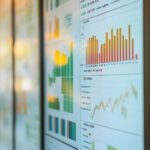Zennemis – Did you know that nearly 70% of nonprofits say data analytics boosts their mission fulfillment? In the fast world of nonprofit work, data analytics is key, not just a bonus. It helps us find insights that make our decisions better and our resources more effective. This leads to bigger impacts in our communities.
In this article, we’ll see how data-driven decisions can help nonprofits tackle common issues. By analyzing data, we can better engage donors, check if our programs work, and improve volunteer experiences. Using data analytics lets us not only spot what needs work but also craft strategies that connect with our supporters. This way, we make the most of every chance to bring about positive change.
Understanding the Role of Data Analytics in Nonprofits
Data analytics is key for nonprofits to make smart decisions. It helps them work better and have a bigger impact. By using data analysis, nonprofits can check how they’re doing and make changes.
This means looking at numbers and turning them into useful information. Good data management lets nonprofits make decisions based on facts. This way, they can plan better and achieve more.
Defining Data Analytics for Nonprofits
Data analytics for nonprofits is about using data to improve. It involves looking at how well they fundraise and the impact of their programs. By doing this, nonprofits can find ways to do better.
It’s important for all nonprofits to understand data. About 75-80% of them have less than $500,000 in revenue. They might not have the tools to analyze data well.
Importance of Data-Driven Decision Making
Using data to make decisions is very important for nonprofits. It helps them work better and be more accountable. They can see how their fundraising and programs are doing.
For example, programs like Girls Code show real results. They help people feel more confident and skilled. This is very useful for planning and using resources wisely.
Challenges Faced by Nonprofits in Data Utilization
Nonprofits face many challenges when using data. They might not have enough money or the right tools. They also might not know how to use data well.
It’s hard for nonprofits to show how their programs work. They need to manage their data well. By solving these problems, nonprofits can use data to their advantage. This will help them do more and better.
Data Analytics for Nonprofits: Key Benefits
Using data analytics can greatly help nonprofits. It improves fundraising and helps measure success. This way, we can use our resources better and make a bigger difference.
Enhancing Fundraising Efforts
Data helps nonprofits raise more money. By looking at who donates and how often, we can reach out better. This makes our appeals more effective, especially through emails.
Knowing what donors like helps us use our money wisely. This leads to more donations and better fundraising.
Streamlining Operations and Resource Management
Data analytics makes nonprofits work better. It helps us find what needs fixing and makes tasks easier. This means we talk more clearly and make decisions faster.
Using data helps us manage our resources well. This means we focus on the most important projects and use our money where it counts.
Measuring Nonprofit Impact with Precision
Measuring success is key for nonprofits. Data analytics gives us the tools to do this. We can see how well our programs work and make them better.
This way, we can show our community we’re doing good work. It builds trust and shows we’re accountable.
Utilizing Data Visualization Tools for Nonprofit Success
In the fast-changing world of nonprofit work, using data visualization tools is key for making good decisions. These tools turn complex data into easy-to-understand visuals. This helps nonprofits share their findings clearly and manage their data better.
Overview of Popular Data Visualization Tools
Tools like Tableau, Power BI, and Google Data Studio are popular for nonprofit data analysis. Tableau lets nonprofits watch their progress in real-time, tracking donations and program success. It also helps predict future trends, making sure programs meet community needs.
These tools offer different ways to show data, like interactive dashboards and infographics. They meet various nonprofit needs and help make decisions based on data.
Creating Compelling Reports for Stakeholders
Good reporting is crucial for keeping stakeholders involved and supporting the cause. Using advanced data visualization, we can make our reports tell powerful stories. This makes it easy for donors, board members, and volunteers to understand the nonprofit’s impact.
Tools like Salesforce help create data stories that really connect with people. This ensures important information is shared clearly and effectively.
Improving Donor Engagement Through Visual Data Presentation
Keeping donors engaged is vital for fundraising success. By showing data on how programs are doing and success stories, we highlight the difference donors make. This approach not only improves donor experiences but also builds stronger relationships, leading to more support and bigger donations.
Effective visual storytelling lets nonprofits share their mission and impact clearly with the communities they serve.
Best Practices for Nonprofit Data Management
Effective nonprofit data management is key to advancing our missions. We must focus on several foundational practices. These practices improve our operations, ensure compliance, and promote data-driven decision making.
Establishing Data Governance Policies
Robust data governance policies are crucial for nonprofits. They help maintain data integrity and follow regulations. We need clear guidelines for data access, use, and security.
Such policies protect sensitive information and build trust in our data. Assigning responsibilities to stakeholders ensures everyone uses data responsibly.
Implementing Effective Data Quality Assurance
Data quality assurance is vital for making accurate decisions. We must conduct regular audits to find and fix errors. Using a centralized database system improves data security and integrity.
Regular data clean-ups, following regulations like GDPR, keep us compliant. This also protects us from fines or legal problems.
Building a Data-Driven Culture within the Organization
A data-driven culture empowers all team members to work with data effectively. Training on data literacy is essential. It helps staff understand and use data well.
Encouraging open discussions about data findings boosts teamwork. This leads to better nonprofit data analysis. Data helps us make strategic decisions and increase our impact.
Conclusion
Using data analytics for nonprofits is a big step forward in making real change. It helps us make better decisions, work more efficiently, and measure our impact more accurately. This way, we can help people now and plan for the future.
Good data management is key to making smart choices and getting better over time. Leaders who use data analytics help their organizations stay ahead. Groups like charity: water and Feeding America show how data can change things for the better.
We face challenges like not having enough resources and needing to keep donors interested. Investing in our data systems is essential. It helps us use our resources wisely and connect with our supporters. By using data, we can grow, adapt, and make a bigger difference in the lives of others.
FAQ
What is data analytics for nonprofits?
Data analytics for nonprofits means using data to make smart choices. It helps us understand our work better. This way, we can do our job better and help more people.
How does data-driven decision making benefit nonprofits?
Using data to make decisions helps nonprofits a lot. It lets us know what works and what doesn’t. This way, we can use our resources wisely and connect better with our supporters.
What challenges do nonprofits face in utilizing data?
Nonprofits often struggle with using data. They might not have enough money, or the right skills. It’s hard to measure how well we’re doing. But, overcoming these challenges can really help us grow.
How can data analytics enhance fundraising efforts for nonprofits?
Data analytics can make fundraising better. It helps us understand who gives and why. This way, we can reach out to the right people and get more donations.
What role do data visualization tools play for nonprofits?
Data visualization tools like Tableau and Google Data Studio are very helpful. They turn complicated data into easy-to-understand pictures. This makes it easier for everyone to see and understand our work.
Why is measuring nonprofit impact important?
Measuring our impact is key. It shows our work is worth it to donors and supporters. Data analytics helps us track how well we’re doing. This way, we can keep getting better at helping our community.
What best practices exist for nonprofit data management?
Good data management is crucial. It means having clear rules and making sure data is accurate. This helps us make smart choices and grow as an organization.
How can nonprofits engage donors through data?
Nonprofits can show donors how their money helps. Using pictures and stories can make a big difference. It shows donors the real impact of their support and keeps them involved.




